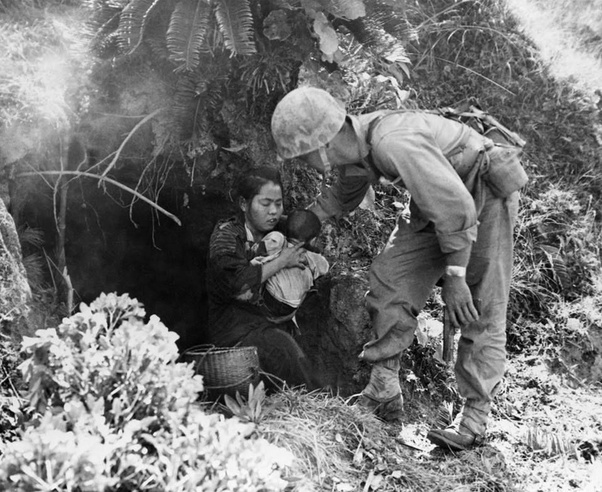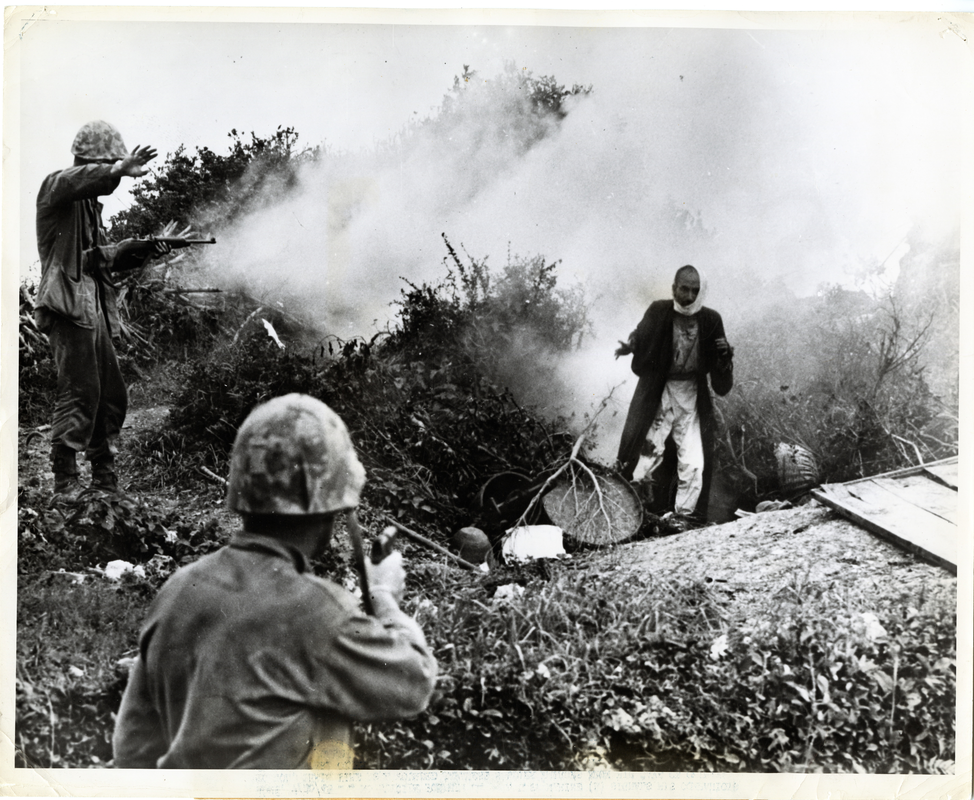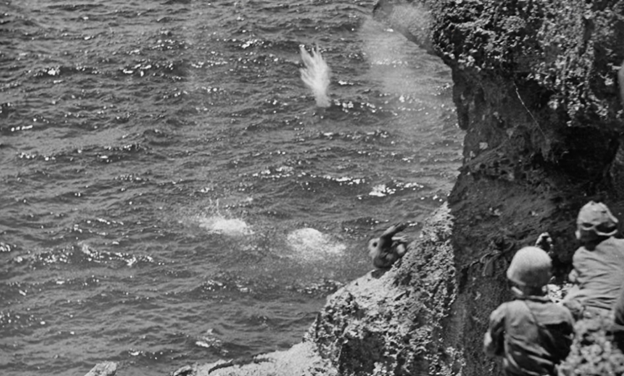|
Guest Post by Tim Qiu, Instagram handle @asianhistoryaddict During the second world war, the Imperial Japanese military inflicted horror, grief, and mass destruction against its adversaries across the Pacific theatre. However, what is less well known are the atrocities it committed against its own people and other innocent civilians. With the military situation growing increasingly dire in 1944, Japanese propagandists intensified their efforts to dehumanize their enemies. British, Australian, and American troops were often portrayed as rapists and sadists, and were even accused of, “running over male captives with Jeeps and raping female captives before brutally torturing them to death.” There were more rumors of harsh treatment for Japanese prisoners of war, including live mutilation and cannibalism. Propaganda combined with rumor caused many civilians caught between Japanese and American forces to either hide with Japanese soldiers or take their own lives - along with those of their loved ones. This was to avoid the shame and disgrace of being captured or avoid the assumed brutality and torture at the hands of Allied forces. One important example of this behavior was seen on the island of Saipan. Women, many with children in their arms, leapt from cliffs by the hundreds off the infamous Suicide and Banzai Cliffs to evade capture. Fathers slit their children’s throats before tossing them into the sea to be washed away. Mothers drowned themselves and their children, hoping to see them in the afterlife. It is estimated that between 800 to 1,000 civilians died by suicide during the month-long battle of Saipan.  5/9/1945- Okinawa, Japan: Eleven Okinawa civilians who were huddled in this hillside cave were rescued when a passing Marine patrol heard a baby crying. After being assured that no harm would come to them, they emerged from their hideout and here a leatherneck lends a hand to a mother and baby. Source: US Marine Corps Records As the last major battle of World War Two in the Pacific theatre, Okinawa was no exception to the death and devastation inflicted during the Allied island-hopping campaign. There, Japanese soldiers disguised as civilians tried infiltrating American lines to wage guerilla warfare, sowing distrust among American sentries towards misplaced refugees seeking shelter from the killing. Those who decided to hide in caves and dugouts with Japanese soldiers met grim fates. They were often either obliterated by unaware American troops with “blowtorch and corkscrew” (military slang for a standard method of clearing suspected Japanese bunkers using high-explosives and incendiary weapons) or died in forced Banzai charges, armed only with sharpened bamboo sticks and other medieval-style weaponry. Japanese soldiers also used Okinawans as human shields, threatening death if they did not obey their instructions, but in doing so who were killed nevertheless. Traps were set by the Japanese to lure American soldiers into danger. In one case, a wounded civilian lying on a doorstep waved the Americans away because of an explosive tripwire. The Americans safely disarmed the bomb and rescued the woman. Unfortunately, the bloodshed on Okinawa did not end there. Countless civilians were caught in the crossfire while trying to take refuge, with many misidentified as enemy soldiers. Streams and rivers were filled with bodies while muddy roads and shell craters often contained dismembered corpses swarming with flies. During heavy fighting, US Marine Howard Terry recalled accidently killing an unarmed boy holding a surrender leaflet that he thought was a Japanese soldier. It was dark and his reflexes had taken over. This event haunted him well after the war ended. By the end of the battle on Okinawa, between 120 to 140 thousand civilian lives were lost, or nearly 30 percent of the local population at the time.  Wounded Japanese soldier emerging from cave to surrender to U.S. Marines; smoke (likely phosphorus) visible near cave. Official Caption: "Rome. 7/25/45--No suicide for him--A U.S. Marine (L) signals his companions to hold their fire as a wounded Japanese soldier emerges from his cave on Okinawa to surrender. Other Japanese in the cave gave up soon after. Source: WWII National Museum Digital Archives To this day, there is an ongoing disagreement between Okinawa's local government and Japan's national government over the role of the Japanese military in civilian mass suicides during the battle. One nation’s military actions resulted in the immeasurable suffering of innocent civilians, yet it is important for the survivors, their descendants, and for us to remember the horror, acknowledge it and not try to erase it, or the memories of the innocents who unnecessarily lost so much in the Pacific theatre of war.
__ SOURCES __ https://wisvetsmuseum.com/blog/japanese_propaganda_wwii/ https://library.tamucc.edu/exhibits/s/hist4350/page/okinawa https://www.theguardian.com/world/2007/jul/06/japan.schoolsworldwide https://www.reuters.com/article/us-japan-history-okinawa-idUST29175620070406 https://www.atomicheritage.org/history/japanese-mass-suicides https://en.wikipedia.org/wiki/Suicide_Cliff https://theconversation.com/the-forgotten-survivors-of-war-without-mercy-in-the-pacific-27959 https://www.warhistoryonline.com/instant-articles/the-horrific-mass-suicides.html Book- Bloody Okinawa: The Last Great Battle of World War II by Joseph Wheelan (chapter 14), author of many other historical books focusing on the Pacific War.
1 Comment
Mike Tuggle
6/11/2024 12:53:16 pm
My father was in the Navy fighting in the South Pacific during the war. He never talked about the war very often, but one of the memories he shared with me was the civilians jumping off the cliffs at Saipan. He said the bay was full of bodies that had been dead for many days (women and children). He told me he witnessed them jumping off the cliffs with babies in hand. There were so many bodies that his ship would randomly hit them. He said he could still smell the smell of the swollen up bodies exploding as his ship hit them. He actually cried when he told me this. The Japs were evil, and they fought to the death. Our greatest generation scarficed so much for us so we could have our freedom. The true heroes of the war never made it back home. I am so indebted to all of the men and women that fought in the war. Especially the ones that did not make it back.
Reply
Leave a Reply. |
- Home
- Stories
-
Internship
- Summer 2024 Internship
- Summer 2023 Internship
- Fall 2022 Internship
- Summer 2022 Internship
- Summer 2021 Internship
- Fall 2020- Spring 2021 Internship
- Summer 2020 Internship
- Fall 2019 Internship
- Summer 2019 Internship >
- School Year 2018-2019 Internship
- Summer 2018 Internship >
- Fall 2017 Internship
- Summer 2017 Internship >
- Books
- Archives
-
Resource Page
-
Supplementary Research Guides
>
- Unit 731 - Guide >
-
Philippines' Resistance - Guide
>
- Philippines World War II Timeline
- The Japanese Invasion & Conquest of the Philippines
- Bataan Death March
- Formation of Underground Philippines Resistance
- Supplies of the Guerrilla Fighters
- The Hukbalahap
- Hunter's ROTC
- Marking's Guerrillas
- United States Army Forces in the Philippines of Northern Luzon (USAFIP-NL)
- The Aetas
- Chinese and Filipino-Chinese Nationalist Guerrilla Units
- The Female Faces of the Philippine Guerrillas
- Rising Sun Flag - Guide >
- Pinay Guerrilleras - Guide >
- Fall of Singapore - Guide >
- Three Years and Eight Months - Guide >
- Siamese Sovereignty - Guide >
- The Khabarovsk War Crimes Trial - Guide >
- Unit 731 Cover-up : The Operation Paperclip of the East - Guide >
- Marutas of Unit 731 - Guide >
- Prince Konoe Memoir - Guide >
- Competing Empires in Burma - Guide >
- Battle of Shanghai - Guide >
- Ishi Shiro - Guide >
- Taiwan The Israel of the East - Guide >
- Seeking Justice for Biological Warfare Victims of Unit 731 - Guide >
- Rice and Revolution - Guide >
- Clash of Empires - Guide >
-
Hunger for Power and Self-SufficiencyI - Guide
>
- The Influence of War Rations on Post-War Culinary Transformations
- How World War II Complicated Food Scarcity and Invention
- American Military Innovations
- Government-Sponsored Food Inventions in Europe during World War II
- Feeding the Army: The Adaptation of Japanese Military Cuisine and Its Impact on the Philippines
- Mixed Dishes: Culinary Innovations Driven by Necessity and Food Scarcity
-
Denial A Quick Look of History of Comfort Women and Present Days’ Complication - Guide
>
- The Comfort Women System and the Fight for Recognition
- The Role of Activism and International Pressure
- The Controversy over Japanese History Textbooks
- The Sonyŏsang Statue and the Symbolism of Public Memorials
- Activism and Support from Japanese Citizens
- The Future of Comfort Women Memorials and Education
- Echoes of Empire: The Power of Japanese Propaganda - Guide >
- Lesson Plans >
-
Supplementary Research Guides
>
|
Pacific Atrocities Education
730 Commercial Street San Francisco, CA 94108 415-988-9889 |
Copyright © 2021 Pacific Atrocities Education.
We are a registered 501 (c)(3) charity. |
- Home
- Stories
-
Internship
- Summer 2024 Internship
- Summer 2023 Internship
- Fall 2022 Internship
- Summer 2022 Internship
- Summer 2021 Internship
- Fall 2020- Spring 2021 Internship
- Summer 2020 Internship
- Fall 2019 Internship
- Summer 2019 Internship >
- School Year 2018-2019 Internship
- Summer 2018 Internship >
- Fall 2017 Internship
- Summer 2017 Internship >
- Books
- Archives
-
Resource Page
-
Supplementary Research Guides
>
- Unit 731 - Guide >
-
Philippines' Resistance - Guide
>
- Philippines World War II Timeline
- The Japanese Invasion & Conquest of the Philippines
- Bataan Death March
- Formation of Underground Philippines Resistance
- Supplies of the Guerrilla Fighters
- The Hukbalahap
- Hunter's ROTC
- Marking's Guerrillas
- United States Army Forces in the Philippines of Northern Luzon (USAFIP-NL)
- The Aetas
- Chinese and Filipino-Chinese Nationalist Guerrilla Units
- The Female Faces of the Philippine Guerrillas
- Rising Sun Flag - Guide >
- Pinay Guerrilleras - Guide >
- Fall of Singapore - Guide >
- Three Years and Eight Months - Guide >
- Siamese Sovereignty - Guide >
- The Khabarovsk War Crimes Trial - Guide >
- Unit 731 Cover-up : The Operation Paperclip of the East - Guide >
- Marutas of Unit 731 - Guide >
- Prince Konoe Memoir - Guide >
- Competing Empires in Burma - Guide >
- Battle of Shanghai - Guide >
- Ishi Shiro - Guide >
- Taiwan The Israel of the East - Guide >
- Seeking Justice for Biological Warfare Victims of Unit 731 - Guide >
- Rice and Revolution - Guide >
- Clash of Empires - Guide >
-
Hunger for Power and Self-SufficiencyI - Guide
>
- The Influence of War Rations on Post-War Culinary Transformations
- How World War II Complicated Food Scarcity and Invention
- American Military Innovations
- Government-Sponsored Food Inventions in Europe during World War II
- Feeding the Army: The Adaptation of Japanese Military Cuisine and Its Impact on the Philippines
- Mixed Dishes: Culinary Innovations Driven by Necessity and Food Scarcity
-
Denial A Quick Look of History of Comfort Women and Present Days’ Complication - Guide
>
- The Comfort Women System and the Fight for Recognition
- The Role of Activism and International Pressure
- The Controversy over Japanese History Textbooks
- The Sonyŏsang Statue and the Symbolism of Public Memorials
- Activism and Support from Japanese Citizens
- The Future of Comfort Women Memorials and Education
- Echoes of Empire: The Power of Japanese Propaganda - Guide >
- Lesson Plans >
-
Supplementary Research Guides
>
